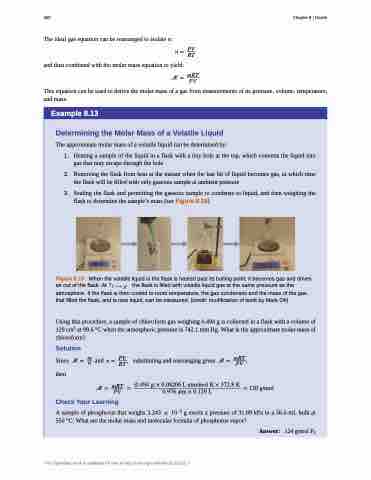Page 430 - Chemistry--atom first
P. 430
420
Chapter 8 | Gases
The ideal gas equation can be rearranged to isolate n:
� � ��
and then combined with the molar mass equation to yield:
�� ��� ��
This equation can be used to derive the molar mass of a gas from measurements of its pressure, volume, temperature, and mass.
��
Example 8.13
Determining the Molar Mass of a Volatile Liquid
The approximate molar mass of a volatile liquid can be determined by:
1. Heating a sample of the liquid in a flask with a tiny hole at the top, which converts the liquid into gas that may escape through the hole
2. Removing the flask from heat at the instant when the last bit of liquid becomes gas, at which time the flask will be filled with only gaseous sample at ambient pressure
3. Sealing the flask and permitting the gaseous sample to condense to liquid, and then weighing the flask to determine the sample’s mass (see Figure 8.19)
Figure 8.19 When the volatile liquid in the flask is heated past its boiling point, it becomes gas and drives air out of the flask. At �� � �� the flask is filled with volatile liquid gas at the same pressure as the
atmosphere. If the flask is then cooled to room temperature, the gas condenses and the mass of the gas that filled the flask, and is now liquid, can be measured. (credit: modification of work by Mark Ott)
Using this procedure, a sample of chloroform gas weighing 0.494 g is collected in a flask with a volume of 129 cm3 at 99.6 °C when the atmospheric pressure is 742.1 mm Hg. What is the approximate molar mass of chloroform?
Solution
Since � � �� and � � �� � substituting and rearranging gives � � ��� � �� ��
then
� � ��� � ������� ��� � ������� ��������� � � ����� � � ��� ������ �� ����� ��� � ����� �
Check Your Learning
A sample of phosphorus that weighs 3.243 � 10−2 g exerts a pressure of 31.89 kPa in a 56.0-mL bulb at 550 °C. What are the molar mass and molecular formula of phosphorus vapor?
Answer: 124 g/mol P4
This OpenStax book is available for free at http://cnx.org/content/col12012/1.7


